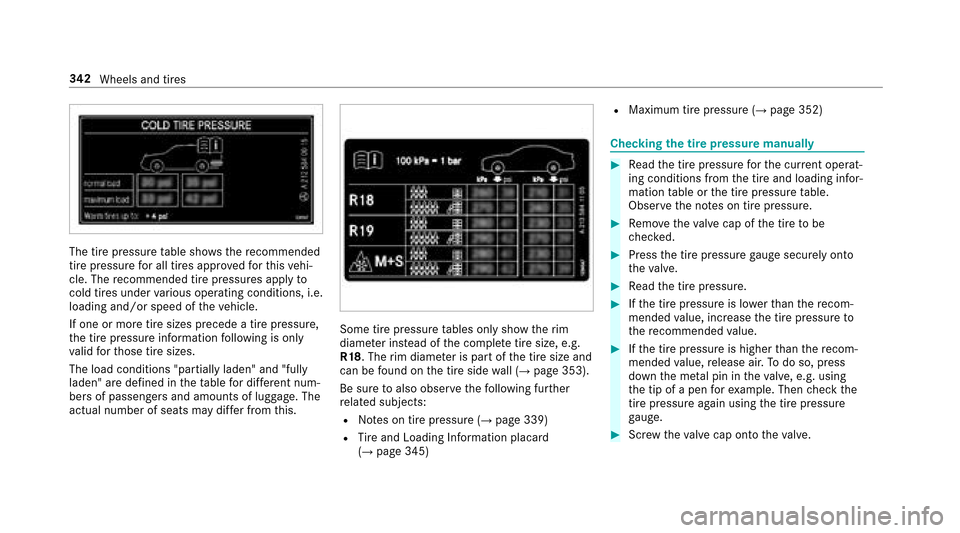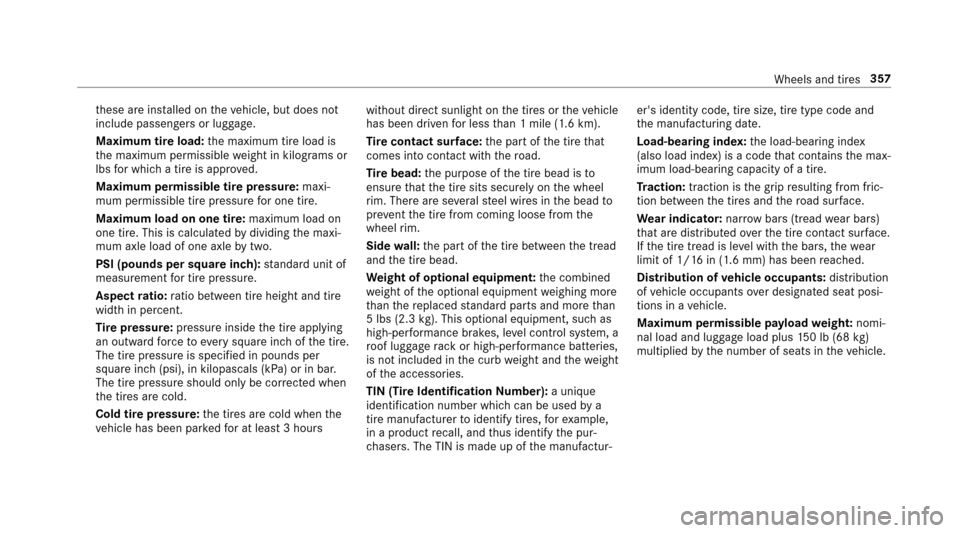2017 MERCEDES-BENZ E43AMG ECU
[x] Cancel search: ECUPage 344 of 482

The tire pressuretable sho ws there commended
tire pressure for all tires app rove dfo rth is vehi‐
cle. The recommended tire pressures apply to
cold tires under various operating conditions, i.e.
loading and/or speed of theve hicle.
If one or more tire sizes precede a tire pressure,
th e tire pressure information following is only
va lid forth ose tire sizes.
The load conditions "partially laden" and "fully
laden" are defined in theta ble for dif fere nt num‐
be rs of passengers and amounts of luggage. The
actual number of seats may dif fer from this.
Some tire pressure tables only show therim
diame ter ins tead of the comple tetire size, e.g.
R18 . The rim diame ter is part of the tire size and
can be found on the tire side wall (
→page 353).
Be sure toalso observ eth efo llowing fur ther
re lated subjects:
RNo tes on tire pressure (→page 339)
RTire and Loading Info rmation placard
(→page 345)
RMaximum tire pressure (→page 352)
Checking the tire pressure manually
#Re ad the tire pressure forth e cur rent operat‐
ing conditions from the tire and loading infor‐
mation table or the tire pressure table.
Obser vethe no tes on tire pressure.
#Re mo vetheva lve cap of the tire tobe
ch ecked.
#Press the tire pressure gauge securely onto
th eva lve.
#Re ad the tire pressure.
#Ifth e tire pressure is lo werth an there com‐
mended value, inc rease the tire pressure to
th ere commended value.
#Ifth e tire pressure is higher than there com‐
mended value, release air. Todo so, press
down the me tal pin in theva lve, e.g. using
th e tip of a pen forex ample. Then check the
tire pressure again usingthe tire pressure
ga uge.
#Sc rew theva lve cap onto theva lve.
34 2
Wheels and tires
Page 359 of 482

these are ins talled on theve hicle, but does not
include passengers or luggage.
Maximum tire load: the maximum tire load is
th e maximum permissible weight in kilog rams or
lbs for which a tire is appr oved.
Maximum permissible tire pressure: maxi‐
mum permissible tire pressure for one tire.
Maximum load on one tire: maximum load on
one tire. This is calculated bydividing the maxi‐
mum axle load of one axle bytwo.
PSI (pounds per square in ch):standard unit of
measurement for tire pressure .
Aspect ratio: ratio between tire height and tire
width in pe rcent.
Ti re pressure: pressure inside the tire applying
an outward forc eto eve rysquare inch of the tire.
The tire pressure is specified in pounds per
square inch (psi), in kilopascals (kPa) or in bar.
The tire pressure should only be cor rected when
th e tires are cold.
Cold tire pressure: the tires are cold when the
ve hicle has been par kedfo r at least 3 hours without direct sunlight on
the tires or theve hicle
has been driven for less than 1 mile (1.6 km).
Ti re contact sur face: the part of the tire that
comes into con tact wi th thero ad.
Ti re bead: the purpose of the tire bead is to
ensure that the tire sits securely on the wheel
ri m. There are se veralst eel wires in the bead to
pr eve nt
the t
ire from coming loose from the
wheel rim.
Side wall:the part of the tire between the tread
and the tire bead.
We ight of optional equipment: the combined
we ight of the optional equipment weighing more
th an there placed standard parts and more than
5 lbs (2.3 kg).This optional equipment, such as
high-per form ance brakes, le vel control sy stem, a
ro of luggage rack or high-per form ance batte ries,
is not included in the curb weight and thewe ight
of the accessories.
TIN (Tire Identification Number): a unique
identification number which can be used bya
tire manufactu rerto identify tires, forex ample,
in a product recall, and thus identify the pur‐
ch asers. The TIN is made up of the manufactur‐ er's identity code, tire size, tire type code and
th
e manufacturing date.
Load-bearing index: the load-bearing index
(also load index) is a code that con tains the max‐
imum load-bearing capacity of a tire.
Tr action: traction is the grip resulting from fric‐
tion between the tires and thero ad sur face.
We ar indicator: narrow bars (tread wear bars)
th at are distributed overth e tire conta ct surface.
If th e tire tread is le vel with the bars, thewe ar
limit of 1/ 16in (1.6 mm) has been reached.
Distribution of vehicle occupants: distribution
of vehicle occupants
over design
ated seat posi‐
tions in a vehicle.
Maximum permissible pa yload weight: nomi‐
nal load and luggage load plus 150 lb (68 kg)
multiplied bythe number of seats in theve hicle.
Wheels and tires 357
Page 398 of 482

Displaymessages
Possible causes/consequences and MSolutions
�)�U�R�Q�W �3�D�V�V�H�Q�J�H�U �$�L�U�E�D�J
�(�Q�D�E�O�H�G �6�H�H �2�S�H�U�D�W�R�U�
�V
�0�D�Q�X�D�O *T
he front passenger airbag and knee airbags are enabled during the journey:
REven when a child, a small adult or an object weighing less than the sy stem weight thre shold is located on the
front passenger seat.
REven when the front passenger seat is not occupied.
The sy stem may de tect objects or forc es applying additional weight on the seat.
&
WARNING Risk of injury orfata l injury byusing a child restra int sy stem with the front passenger airbag
enabled
If yo u secure a child in a child restra int sy stem on the front passenger seat and the front passenger airbag is
enabled, the front passenger airbag can deploy in theev ent of an accident.
The child could be stru ck bythe airbag.
#Make sure, bo thbefore and during the journe y,that thest atus of the front passenger airbag is cor rect.
#Pull over and stop theve hicle safely as soon as possible, paying attention toroad and traf fic conditions.
#Check thest atus of the automatic front passenger airbag shutoff .
#If necessar y,consult a qualified specialist workshop immediatel y.
396
Display messages and warning/indicator lamps
Page 461 of 482

LaneKeeping Assist
see Active Lane Keeping Assist
Language Notes .................................................. 236
Setting .................................................2 36
Last destinations Selecting ............................................. 242
LA TC H-type (ISOFIX) child seat
attachment
Installing ................................................ 49
No tes ..................................................... 48
Le vel control sy stem
see AIR BODY CONTROL
Light switch Overview .............................................. 112
Lighting .................................................... .116
Lighting see Lights
Lights ................................................ .112,11 6
Ad aptive Highbeam Assist .................. .114
Ad justing the instrument lighting ........ 203
Au tomatic driving lights ....................... 113
Combination switch............................. 113 Corne
ring light function ....................... 114
Hazard warning lights .......................... 114
High beam ........................................... 113
High-beam flasher ................................ 113
Light switch .......................................... 112
Low beam ............................................ 112
Pa rking lights .......... ...
.........................
.112
Re ar fog light ........................................1 13
Re sponsibility for lighting sy stems ...... .112
Setting the sur round lighting ................ 116
St anding lights .................................... .112
Tu rn signal light .................................... 113
Limited Warranty
Ve hicle .................................................. 26
Live Traf fic Information
Displaying subscri ption information .... 252
Re gis tering on Mercedes me ............... 252
Load index (ti res) .................................... 353
Load rating (ti res) ................................... 353
Loading guidelines .................................... 95
Loading information table ......................345
Loads Securing ................................................ 95 Lo
cking ...................................................... .55
Locking/unlocking .............................. 60, 63
Low beam Swit ching on/off .................................. 112
Lo weri ng
Ve hicle ................................................ 366
Lu bricant additives
see Additives
Lu ggage
Securing ................................................ 95
Lu mb
ar support
see Lumbar support (4-w ay)
Lu mbar support (4-w ay).......................... .86
M
Maintenance Vehicle ................................................... 21
Maintenance see ASS YST PLUS
Making a call via theove rhead con‐
trol panel
Mercedes-Benz mbrace
®(USA only) .. .272
Index 459
Page 472 of 482

Switch-off delay timeInterior .................................................1 17
Switching the sur round sound on/off
Burmes ter
®sur round sound sy stem ... .301
Synchronization function Activating/deactivating (control
panel) .................................................. 125
Sy stem settings
Language ............................................ .236
No tes on language selection ............... 236
Re set function (multimedia sy stem) ... .239
Setting the dis tance unit ..................... 236
Software upda te.................................. 238
Sy stem settings
see Multimedia sy stem
T
Ta ilgate
see Trunk lid
Ta ilpipes (Care) ........................................ 313
Ta nk capacity
Fu el ...................................................... 374
Re ser ve(fuel) ...................................... .374 Te
ch nical data
Information .......................................... 368
Ti re pressure monitoring sy stem ......... 345
Ve hicle identification plate .................. 370
Te lephone ................................................ .260
Ac tivating functions du ring a call ........ 264
Call and ringtone volume .................... .263
Calls with se veral participants ............ .264
Commands (Voice Control Sy stem) ..... 218
Connecting a mobile phone (Near
Field Communication (NFC)) .......... .....2 62
Connecting a mobile phone (Pass‐
ke y) ...................................................... 26 1
Connectin g amobile phone (Secur e
Simple Pairing) .................................... .261
Disconnecting the mobile phone ......... 262
Incoming call during an existing call .... 264
Menu (on-board computer) .................. 208
Mobile phone voice recognition .......... 263
No tes ...... ............................................ 260
R
e ception and transmission volume .... 263
Swit ching mobile phones .................... 262
Swit ching mobile phones (Near Field
Communication (NFC)) ........................ 262
Te lephone menu overview .................. .260 Te
lephone operation ............................ 263
Using Near Field Communication
(NFC) .................................................. .262
Wi reless charging (mobile phone) ........ 110
Te lephone
see Mobile phone
Te lephone number
Dialing (on-board computer) ................ 208
Te mp erature ............................................ .124
Te mp erature grade .................................. 350
Te xt messages ......................................... 267
Calling a sender ..................................2 68
Commands (Voice Control Sy stem) ..... 220
Composing .......................................... 268
Configuring thete xt message s dis‐
pla yed .................................................. 267
Deleting ...............................................2 69
No tes ................................................... 267
Re ad-aloud function .... ........................ 268
Re ading .............................................. .268
Re plying .............................................. 268
Sending ...............................................2 68
Through-loading feature
see Seat
47 0
Index